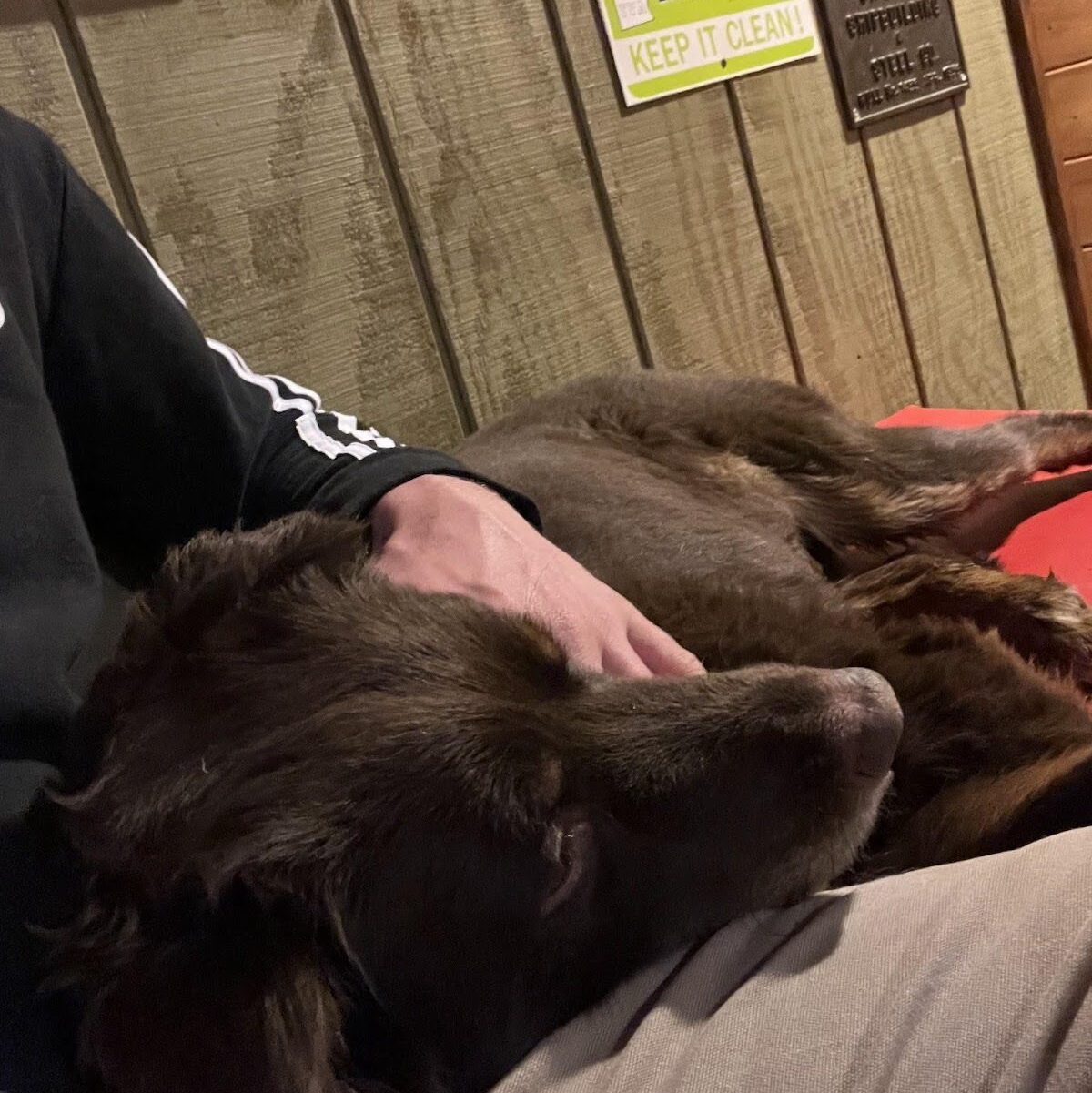- National Volunteer Weekby Sara
Happy National Volunteer Week! Collectively, our incredible volunteers have contributed over 480 hours since January in their efforts to support several projects at Ney. Of course, National Volunteer Week is a great time to celebrate all that they have accomplished so far this year. Let’s take a closer look at some stand out projects!
2025 started off strong as our Board of Directors continued to dedicate their expertise to Ney in the new year. Ney’s eight board members and several committee volunteers collaborate to hold productive meetings each month. Topics such as park stewardship, financial choices, plus policy and program development are always the center of these conversations and guide the goals we make at Ney. So far this year, our board and committee members have contributed 50 hours of their time to ensure that Ney continues to grow its ability to inspire appreciation and respect for nature.
Next, on Saturday, February 15th, nine volunteers braved the cold and windy weather to support our Candlelight Event. Hosting this classic free community event wouldn’t be possible without our volunteers. Together with our staff, they placed and lit our luminaries, served smores and hot chocolate, and tended the bonfire. All of this work added up to over 20 hours of time. Our staff is so grateful that this time is filled with energy and excitement from the volunteers, helping our 160 participants feel warm and welcome on a cold winter evening.
There are so many outstanding volunteer projects to celebrate from both March and April. Across both months, several of our staff members and volunteers were working to support our maple syrup production. Once all of our trees were tapped, volunteers continued to assist our efforts by collecting sap every day, starting our boils, and pulling all the taps when the season came to an end. When you pour your first drop of Ney Maple Syrup onto fluffy morning pancakes, please be sure to thank our seven impressive volunteers who helped make that syrup possible.
In addition to those seven volunteers, we welcomed 29 students from the Compass Learning Center in New Prague to help us remove our taps at the end of the syruping season. Setting out on foot, this large group skillfully took down more than 50 taps and collection bags in just over one hour. It is always a great experience to help students participate in serving their community.
The Compass Learning Center students were not the only school group to take time out of their day to support Ney’s goals. Minnesota New Country School students traveled up the hill from Henderson on three separate occasions so far this year. During their first visit, several students supported our AmeriCorps member’s effort to continue removing Buckthorn throughout the park. Next, across two separate workdays, a few more students cleaned out, prepared, and placed predator guards on all of our Wood Duck houses. Altogether, they contributed over 70 hours of environmental stewardship.
If all of these incredible accomplishments have left you wondering how you can either continue volunteering at Ney or join your first workday, you’re in luck. I am so very happy to announce that our Great Oaks restoration project will be celebrating its five year anniversary on Saturday, April 26th from 9am to noon. To celebrate and continue the development of the area, we are hosting a seed scattering party! Please join us and invite your friends to clear leaf litter and prepare the soil to seed a savanna grass and flower mix under our Seven Sisters. You won’t want to miss this exciting celebration.
Thank you to all of our wonderful volunteers who dedicate their time, expertise, and happy spirits to Ney. Our staff hopes you feel appreciated and celebrated not only during National Volunteer Week, but all year round.
P.S. If you’re interested in continuing the fun of thanking and celebrating our wonderful volunteers, please mark your calendars for our upcoming volunteer appreciation evening on Tuesday, July 15th. Stay tuned for more information!
- The Trashiest Week of My Life: Cleaning Up the Mississippiby Sam
The Mississippi River drains water from about 1.2 million square miles of land according to the National Parks Service. Unfortunately, water is not the only thing that makes its way from land into the river. Garbage such as plastic bottles, tires, plastic bags and anything else you can imagine make their way into the Mississippi either by washing in from flooding, flowing in from other rivers, and even littering directly into the river. Regardless of how this problem is caused, it can only be changed if people are willing to put in the work to pick it up.
This story starts in November of 2024 while I was attending the Minnesota Naturalists Association Conference. Our keynote speaker for this event was Chad Pregracke and I had the honor of sitting by him before his presentation. If I had known then what I know now, I would have been even more excited for the chance to have a conversation with such an enthusiastic person. During his presentation Chad talked about how he founded the non-profit “Living Lands and Waters” which protects, preserves and restores the natural environment of the nation’s major rivers and their watersheds. He talked about how he began as a clam diver in the Mississippi who noticed a problem and how that grew into the organization today. As I write this, Living Lands and Waters has removed 13,588,779 pounds of trash.

Living Lands and Waters Tug Boat. Photo taken by Sam Retz. After Chad had finished speaking, he spoke with everyone who came to thank him (which was almost everyone who attended). Once the line had died down I followed suit and went to thank him. I expressed a lot of interest in the work that he and his team were doing, and was blown away when he wanted me to get involved. After a few months of planning and waiting I was able to join the crew on their barge in Memphis Tennessee. I was there for the first week of March for their “alternative spring break”, where college students chose to volunteer over their vacation from school.
I arrived at the airport on Sunday and called an Uber to the boat launch where I would be picked up and brought to the barge. When I got to the launch I was in awe. Having spent my life in Minnesota and Wisconsin, I am used to seeing clean rivers and waterways. While we may pride ourselves on that, what enters the river in the north eventually ends up further downstream. After taking a minute to see exactly what we were up against, I let the crew know I had made it and they sent a boat to pick me up.

McKellar Lake in Memphis, TN. Photo taken by Sam Retz. Once on the barge, I got a tour of where I would be staying for the next few days as well as brief introductions to the crew. To say the crew was welcoming would be an understatement. The time for introductions was short however, because there were still things to prepare for the following days. I helped the crew with whatever tasks I could while getting to know them better. Once we were done with everything we had dinner and spent more time talking before finally going to bed.
The next few days went by in a blur. In the morning we would wake up and have breakfast while we discussed what the plan was, such as where we were cleaning and what was needed. After that we would all get ready and take jon boats, life jackets, gloves and decomposable garbage bags to the boat launch to meet with the volunteers. Once everyone was there we distributed the life jackets, gloves and bags, and took the boats to the area we would be cleaning. While most of the boats were for passengers, some were kept empty to carry bags of garbage back to the barge. Even though each area we moved had more garbage, both the crew and the volunteers were enthusiastic throughout the week. While we picked up garbage we also found trinkets and other items that could be cleaned and saved. The crew added these to the ever growing collection that is displayed in their classroom/ dining room on the barge. With some friendly competition, a lot of grit, and extreme amounts of teamwork, we were able to remove a total of 42,820 pounds of garbage in three and a half days.

Toy collection on the barge. Photo taken by Sam Retz. 
Sam and a team member taking a ride in a discarded bed frame. From Living Lands and Waters Instagram, https://www.instagram.com/p/DG6ZHvOpEvS/?img_index=1. Unfortunately, I had to leave early on Friday and say goodbye to the wonderful friends I made. Though that week may have ended, It helped me realize the things that I can do in my everyday life to make a difference. From picking up the stray piece of garbage on a hiking trail, to opting for reusable materials over plastic, the smallest difference does still make a difference.
I can’t thank Chad and the rest of the crew enough for the amazing experience as well as all of the incredible work they do, and I hope to have another chance to join them and help make our world a cleaner and healthier place.

Louie, the barge dog taking a break with Sam. Photo taken by Sam Retz. We encourage you to learn more about Living Lands and Waters at https://www.livinglandsandwaters.org/.
- Maple Syrup: Support a Sweet Legacyby Sara
Our Maple Syrup season is finally in full swing! After a rainy weekend and temperatures creating the perfect conditions for the sap to flow, we collected over 60 gallons of sap at the beginning of this week. Our very first sap boil of 2025 is just around the corner, and soon, we will have syrup to share with you all. Before then, we have another way that you are invited to participate in our Maple Syruping process.

2016 Maple Syrup Program at Ney. Photo from Ney archives. 
Drilling before hammering in the spile for sap. 2021 at Ney. Photo from Ney archives. Many people can agree that drizzling pure maple syrup over a tower of warm pancakes is one of the best ways to start any morning. Although syrup is a commodity that we may take for granted, after learning all about how syrup is made, it is much easier to fully appreciate nature’s incredible gift. Our staff and volunteers who have helped make this syruping season possible, know exactly what it takes to put a finished bottle on the table. Here’s an overview:
- Back in August of 2024, when the trees still had their leaves, one staff and two volunteers walked our syruping trail to identify new Sugar Maple Trees to tap this season.
- In January of 2025, four volunteers and Ney staff climbed our gravity lines to replace chewed on and old lines.
- Across two different afternoons in February, two volunteers helped Ney staff officially start our syruping season by tapping the Maple trees in our gravity line system.
- Shortly after tapping, staff and one volunteer pressure washed our collection tanks and bulk storage tanks.
- For the next week, staff tapped trees along the syruping trail in the park, collecting any running sap as they went along.
- After all the trees were tapped, staff and a few volunteers collected, measured, and stored sap. We have also had a couple opportunities to complete these steps with young learners visiting the park.
- Another volunteer has helped staff prepare our cooking arch for another season of boiling sap.
- Now, in the coming weeks, staff and additional volunteers will boil the sap, finish it in a smaller pan, filter it one last time, and finally, bottle it.
Of course, Maple Syruping takes quite a great deal of effort. As always, we are very thankful for the hours and excitement our volunteers put into projects like this. Each step along the way brings us closer to nature, inspiring a deeper respect for what it provides.

Volunteers and staff standing in front of the pan of boiling sap. 2016 at Ney. Photo from Ney archives. 
Sap bag filling up in 2025 at Ney. Photo taken by Sara Corbin. While we certainly have a lot on our hands from all of the steps listed above, our staff has been thinking of ways to start our syruping process from the very beginning. After removing dead Ash trees from the pond loop at the beginning of this year, we identified that area as a great place to establish brand new Sugar Maple trees. Now, we are happy to invite you to help us make this very first step of the syruping process possible!
At this year’s Tree Jamboree event held on Saturday, April 26th from 12:30 to 3:30pm, our staff will work together with the community to plant six new Sugar Maple Trees.
Since planting these trees, watching them grow, and enjoying their syrup is a process that we will all share across many generations, our staff is excited to invite you to further support the process by gifting a donation to cover the cost of these trees. Every donation, from $1 to $100, the full cost of one tree, adds to our ability to share syrup for generations to come. By gifting a donation of any amount and helping us plant the Maples at the Tree Jamboree, you can proudly say that you’ve played an active role in supporting the longevity of our syruping efforts.
It is heartwarming to know that these trees will hold a special meaning to us and the members of our community. Thank you for your support and love of maple syrup!
- Back in August of 2024, when the trees still had their leaves, one staff and two volunteers walked our syruping trail to identify new Sugar Maple Trees to tap this season.
- Protect our Park: Keep your pup on a leash!by Eva
As the weather gets warmer, we love seeing all of the visitors at the park, including our 4-legged friends! We know that it can be tempting to let your furry friend roam free of their leash to get some exercise, but we ask that you resist the temptation for the sake of the park. This simple action protects wildlife, maintains the natural beauty of the park, and ensures a safe and enjoyable experience for all visitors (including yourself!)
Protect Wildlife
Ney Nature Center is first and foremost a 446-acre nature preserve. Meaning that we prioritize the preservation of the park before our visitors or even our education programs. The park is home to all kinds of animals, from birds to deer, amphibians to reptiles. When dogs roam off-leash, they can unintentionally disturb or harm these animals by chasing them, disturbing nests, and trampling delicate habitats. By keeping your dog on a leash, you are helping us preserve the chance for wildlife to thrive in the park free of stress or disturbance.
Maintaining the Plants and Trails
Unleashed dogs are more likely to stray off designated trails than those on leash, damaging native plants and contributing to soil erosion (actually, you can do the same by going off-trail). Many parts of our park are carefully maintained by staff and volunteers to preserve specific species or the landscape. When we introduce a furry friend that is stepping on species, digging up dirt, or creating new trails themselves, that preservation work can be set back in its progress or destroyed entirely.Courtesy for Other Park Guests
“No one else is here!” Well maybe not in the parking lot you are parked in or at the time you arrive, but people come and go frequently. Not all visitors are comfortable around dogs, event friendly ones. Some people have allergies, phobias, or simply prefer to enjoy the trails without being approached unexpectedly. That does not even include when other guests have their own dogs that may not be as friendly as yours.As someone who has had many reactive (non-friendly) dogs in my life, while your dog may be friendly, please keep in mind that other people’s dogs may not be. It only takes a split second of either dog feeling threatened or on edge for there to be an attack, and if even one dog isn’t leashed, it can be hard to separate them without getting hurt yourself. Protect yourself and your dog by putting them on a leash.

Leash rules aren’t for fun, they are regulations for a reason. If you didn’t know why before, now you know! Just like you, we love seeing happy, panting dogs on hikes in the park, so help us continue to allow 4-legged guests by leashing up every time you are at Ney Nature Center. Protect wildlife, preserve plants and trails, and be courteous to other guests, all just by using a leash! A simple act with a big impact.
Where can you take your dog instead to run around? Check out the following nearby:
– Le Sueur Dog Park
– Belle Plaine Dog Park
– New Prague Dog Park
– Lonsdale Dog Park
– Saint Peter Dog Park
– Thompson Dog Park (Saint Peter)
– Sniffspot (Private Dog Park Rentals) - Emerald Ash Borer: They’re Here!by AmeriCorps Climate Impact Project Coordinator
Emerald ash borer (EAB) is an invasive insect that has made its way through much of southeastern Minnesota, including the park here at Ney, and continues to spread across the state, killing as many ash trees as it can along the way. These invasive insects lay their eggs directly into the bark grooves of ash trees, so when the eggs hatch, the larvae immediately make their way under the bark to begin feeding. Emerald ash borers feed on the inner layer of the bark that allows the tree to transport water and nutrients, so when this cycle is disrupted, the tree begins to die. In their larval stage, EAB look like flat, white worms, growing to around 1 inch long. As an adult, these beetles can be identified by their iridescent green body and purple abdomen under the wings, growing to only about ½ inch long.
Adult EAB, photo taken by the Oregon Department of Forestry (https://tualatinswcd.org/species/emerald-ash-borer/) One of the easiest ways to identify if an ash tree has been infested with the borer is by blonding on the bark. As the insect makes its way through the tree, the tree will begin to lose the outer layer of its bark, making it look like the bark is “blonding” or becoming lighter in color. If you look up close to the tree, however, you will be able to see that the bark of the tree is actually falling off. In some cases, when the tree has been infested with EAB for a long time or has died already, there will be no bark left along the trunk and branches. In this case, it can be easy to see another common sign of EAB infestation. Under the bark of an infested ash tree, you can often see the tunnels that the larvae feed their way through. These tunnels look like S-shaped galleries winding through the wood. When the bark is still intact, EAB infestation can also be identified by D-shaped exit holes in the bark, where the adult beetles emerge from.
Tunnels and exit holes underneath the bark. Photo by Madi Kes. 
Bark blonding on an ash tree. Photo by Madi Kes. As the emerald ash borer makes its way through Ney’s park, more and more of our ash trees are dying and showing signs of infestation. To manage the spread of this invasive species, we have come up with a plan to identify all the infested ash trees along the trails and mark them for removal. Our removal process of these trees began last weekend, as a group of volunteers came out with their saws and began felling some of the dead ashes along the trails that could be in danger of falling across the path or could potentially become a safety threat to visitors. Though it’s never fun to see sick or dying trees get removed, the ash trees that are getting cut down in our park are still serving a beneficial purpose! Some trees will be chopped into firewood for our future use, and many others will be left along the trails and in the forests to serve as habitat space for other wildlife within the park.
A group of infested ash trees sawed down by volunteers. Photo by Madi Kes. There is still a lot of work to be done to manage the ash tree population at Ney, but we are always grateful for the work that volunteers help us with as we continue to implement management strategies to best serve the environment in our park!

